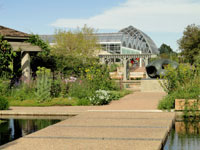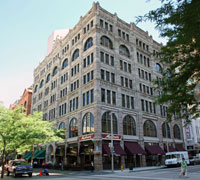 Michael Paglia / Courtesy Michael Paglia |
 Denver Botanic Gardens / Courtesy Wikipedia |
 The Kittredge Building / Courtesy Wikipedia |
Michael Paglia, an art and architecture critic, has written a column for Westword, Denver's alternative weekly, since 1995. He teaches in the art history department at the University of Colorado at Denver and has authored several books and monographs. He also works on arts programming for Denver's local PBS station.
Best Historic Architecture
There’s a wonderful three-building short course in the development of Modern architecture on a street called Glenarm Place, between 16th and 17th Streets. First, there’s the Kittredge Building (1891), a Richardsonian Romanesque office building on the 16th Street corner. Next door is an Art Deco theater called the Paramount Theatre (1930) by local architect Temple Buell. Finally, on the other corner, is the International Style Denver Club building by Raymond Harry Ervin from 1963.
A Western city, Denver’s fortunes were not built on agriculture, like many cities in the Midwest, rather, its economy is rooted in minerals, mining, timber, gold, uranium, and everything coming out of the mountains. As a result, the most prolific period of downtown building was in the 1970s and the 1980s, during the oil boom. We have high-rises all over downtown from that period.
International Modernism came to Denver then. Skidmore, Owings & Merrill designed several buildings during the boom—there was even an SOM Denver office. The tallest, biggest, and most expensive buildings in Colorado were constructed during this period, including the Wells Fargo Center by Philip Johnson, and a number of Kohn Pedersen Fox buildings. It ended with the oil crash of the mid-1980s, and we’ve never returned to that level opulence and ambition in architecture.
The Denver Botanic Gardens, east of Downtown, is a Usonian-style complex. The oldest parts, built in the 1960s, were designed by Victor Hornbein, a local follower of Frank Lloyd Wright. The concrete and plexiglass conservatories look like a futurist vision from the past. In fact, they appear in Sleeper, the 1973 Woody Allen movie about time travel and space. In recent years, the conservatories have been substantially expanded by architect David Tryba.
Arapahoe Acres, a neighborhood south of Downtown, is worth seeing. The mid-century Modern houses were all built in the 1950s and early 1960s. It’s the first post-war Modernist development that was ever listed on the National Register of Historic Places. The neighborhood was planned by a European émigré architect named Eugene Sternberg, along with a designer-developer named Edward Hawkins. More than 100 architect-designed houses, all quite different, in a beautiful site plan. It’s gotten some national attention.
Best Mix of New and Old Architecture
Civic Center, where the State Capitol and the City and County building are located, has a density of important public buildings, ranging in style from Neoclassical to Postmodern
Best Excursions:
West of Downtown, the Red Rocks Amphitheatre is one of the most famous outdoor amphitheaters in the country. Nestled in natural rock formations of red sandstone, it is a Civilian Conservation Core (CCC) project designed by architect Burnham Hoyt. It’s really beautiful. It’s so subtle that it looks natural at first glance.
West of Denver, on I-70 in Genesee, is the Sculptured House (1963) by Charles Deaton. It’s nicknamed the “Sleeper” House because it appears in the above mentioned Woody Allen film. It looks like a flying saucer floating above the pine trees. It’s an amazing house. It’s on the National Register of Historic Places, and it got worldwide publicity when it was first built.

Post a comment to this article
Report Abusive Comment